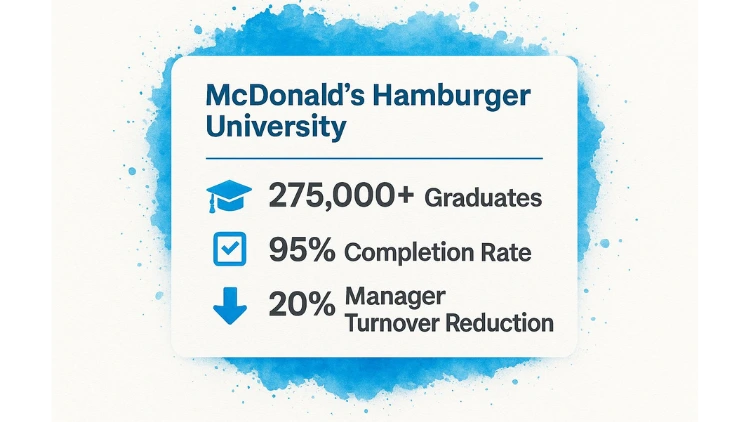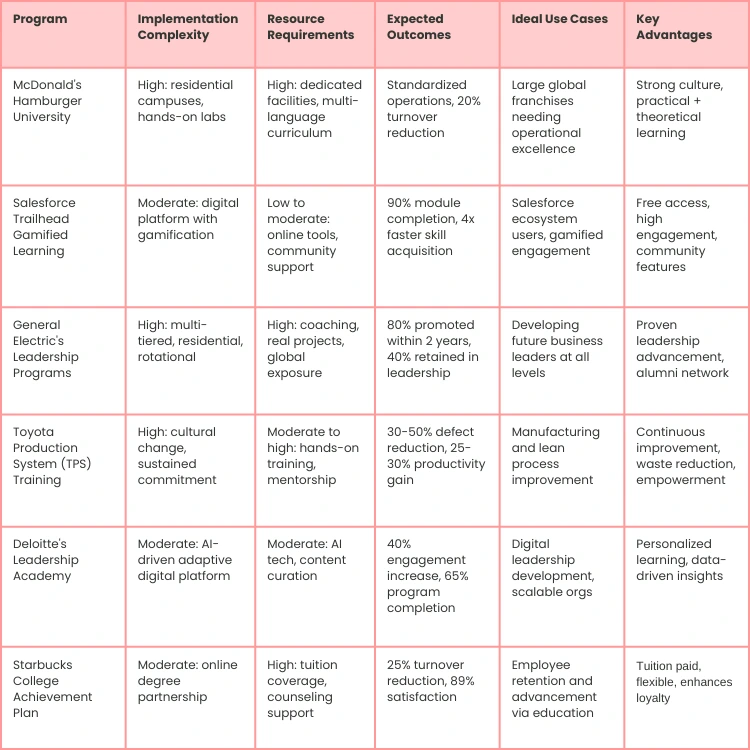Employee Training Program Examples to Boost Your Strategy

Stale training modules and check-the-box exercises no longer cut it. In today's competitive landscape, employee development isn't just a benefit; it's a critical business strategy. An effective training program boosts productivity, skyrockets retention, and builds a resilient workforce ready for any challenge. But what separates a forgettable seminar from a truly transformative learning experience? The answer lies in strategic design and execution, not just content delivery.
To effectively rethink your approach to employee development, it's crucial to understand current staff training best practices that form the foundation of successful programs. Building on that foundation, this article dives deep into 7 world-class employee training program examples from industry giants like Google, McDonald's, and Salesforce. We'll move beyond surface-level descriptions to dissect the strategic thinking behind their success.
You won't find generic success stories here. Instead, you will get a tactical breakdown of how these companies build, implement, and measure their training initiatives. Prepare to gather practical examples and actionable insights you can adapt to build or refine a training program that delivers real, measurable results for your own organization. Let's explore the models that turn training from an expense into a powerful competitive advantage.
Jump To Section

Earn As You Learn
Earn 25% commission when your network purchase Uplyrn courses or subscribe to our annual membership. It’s the best thing ever. Next to learning,
of course.
1. McDonald's Hamburger University
McDonald's Hamburger University is one of the most iconic and enduring employee training program examples in the corporate world. Established in 1961, it has evolved from a basement classroom into a global network of corporate training centers. It provides intensive, hands-on training for restaurant managers, mid-managers, and owner-operators, ensuring operational consistency and leadership excellence across thousands of locations.
The curriculum is a masterclass in standardization and scalability. It covers everything from restaurant operations and service procedures to leadership, business management, and team building. This blend of tactical and strategic training ensures that every graduate not only understands how to run a McDonald's restaurant but also why the specific systems are crucial for success.
Strategic Breakdown
Hamburger University's strategy is built on a foundation of standardization, leadership development, and cultural immersion. The program ensures every manager, regardless of location, upholds the brand's core principles of Quality, Service, Cleanliness, and Value (QSC&V).
- Standardization: Creates a consistent customer experience worldwide by teaching a single, proven operational model.
- Leadership Pipeline: It functions as a clear career progression path, transforming crew members into potential franchise owners.
- Cultural Immersion: The program deeply embeds McDonald's values and history, fostering a strong sense of brand loyalty and ownership among its leaders.
The success of this model has inspired numerous other quick-service restaurants, like KFC and Burger King, to develop similar corporate universities, solidifying its place as a pioneering training strategy.
Actionable Takeaways
You don't need a global empire to apply the principles of Hamburger University. Companies of any size can implement these tactics to build a more effective training program:
- Codify Core Processes: Document your most critical operational procedures.
Practical Example: Create a digital wiki or a physical binder called "The [Your Company] Way" that details step-by-step instructions for key tasks, from handling a customer complaint to closing out a sales deal. This becomes your "single source of truth."
- Develop a Tiered Curriculum: Start with fundamental operational skills before moving to advanced leadership and business management topics.
Actionable Insight: Structure your program in levels (e.g., Level 1: Core Operations, Level 2: Team Leadership, Level 3: Business Acumen). An employee must be certified at one level before accessing the next.
- Integrate Culture Deliberately: Don't just teach tasks; teach the "why" behind your company's mission and values in every training module.
Practical Example: In a customer service training module, don't just teach the script. Start with a story that illustrates your company's commitment to customer satisfaction and explain how the script upholds that value.
For a deeper look into the components that make corporate training truly effective, you can learn more about the facets that corporate training must include in every job.
Program Effectiveness at a Glance
The following infographic highlights key metrics that demonstrate the powerful impact of the Hamburger University program.
These metrics showcase a program that not only boasts a massive alumni network but also achieves exceptional completion rates and delivers tangible business results by significantly reducing manager turnover.

2. Salesforce Trailhead Gamified Learning Platform
Salesforce Trailhead represents a major shift in corporate education, transforming mundane software training into an engaging, gamified experience. Launched in 2014, it is one of the most effective employee training program examples for the modern workforce. Trailhead breaks down complex topics related to Salesforce products, business skills, and technology concepts into bite-sized, interactive modules. Users earn points, badges, and ranks as they complete challenges, making professional development feel more like a game than a chore.
The platform’s success lies in its accessibility and motivational design. It provides a free, self-paced learning path for anyone looking to gain in-demand skills, from administrators to developers and marketers. This approach not only builds a massive talent pool for its ecosystem but also fosters a vibrant community of lifelong learners, with millions of users earning billions of badges.
Strategic Breakdown
Trailhead’s strategy revolves around engagement, accessibility, and community. By making learning fun and rewarding, it lowers the barrier to entry for complex technical skills and encourages continuous upskilling.
- Gamification: Uses points, badges, and leaderboards to create intrinsic motivation and a sense of accomplishment, driving user engagement.
- Microlearning: Content is delivered in small, manageable units, allowing learners to make progress even with limited time.
- Community Integration: Connects learners with a global network of peers and experts, fostering collaboration and shared knowledge.
The platform's model has been so influential that major tech companies like Microsoft and HubSpot have launched their own gamified learning academies, proving its effectiveness in building a skilled and certified user base.
Actionable Takeaways
You don't need a massive budget to gamify your training. The core principles behind Trailhead can be adapted to enhance any corporate learning program:
- Introduce Points and Badges: Assign points for completing modules or quizzes. Create digital badges to recognize achievements for specific skills or course completions.
Practical Example: Use a free tool like Credly or even a shared spreadsheet to track points. Award a "Cybersecurity Sentinel" badge to anyone who completes the annual security training with a perfect score.
- Create Learning Paths: Group related training modules into "trails" or "paths" that guide employees from beginner to advanced levels, providing a clear sense of progression.
Actionable Insight: Name your paths based on job roles, such as the "New Manager Onboarding Trail" or the "Senior Sales Executive Path," to make them immediately relevant.
- Foster Friendly Competition: Implement leaderboards to showcase top learners each month or quarter.
Practical Example: Post the top 5 learners on a specific topic (e.g., "Product Knowledge Champions") in your company's Slack channel or internal newsletter, and offer a small prize like a gift card or lunch with a senior leader.
Platforms like Trailhead are essential tools for addressing the growing skills gap, and you can learn more about why nearly half of all workers may require upgrading to stay competitive.

3. General Electric's Leadership Development Programs
General Electric’s (GE) suite of leadership development programs is legendary, establishing the company as a "CEO factory" for decades. Centered around its Crotonville campus, GE created one of the most comprehensive and influential employee training program examples focused on cultivating a deep bench of future leaders. The approach combines rigorous classroom instruction, challenging rotational assignments, and high-stakes projects to build versatile and resilient executives.
The curriculum is designed to be an immersive, multi-year journey, not a one-off course. High-potential employees are selected for programs that rotate them through different business units and functions, forcing them to adapt quickly and solve real-world problems. This action-learning model ensures that leadership theory is immediately applied to challenges that deliver tangible business value, developing both technical expertise and strategic thinking.
Strategic Breakdown
GE's leadership development strategy is built on early talent identification, experiential learning, and creating a powerful C-suite pipeline. The program is designed to test and develop leaders by putting them in charge of critical initiatives long before they reach senior executive roles.
- Talent Identification: Selects high-potential candidates early in their careers and invests heavily in their growth, ensuring a continuous supply of leadership talent.
- Experiential Learning: Moves beyond theory by using rotational assignments and "action learning" projects to solve real business challenges, making training directly relevant and impactful.
- Pipeline Creation: The programs serve as the primary source for internal promotions to senior leadership, with alumni like the former CEOs of Boeing and 3M, demonstrating its incredible success rate.
This model's effectiveness is so renowned that companies like IBM and P&G, as well as military leadership academies, have adopted similar methodologies to forge their next generation of leaders.
Actionable Takeaways
You don’t need GE's massive scale to build a robust leadership pipeline. Small and mid-sized businesses can adapt these principles to cultivate their own future leaders:
- Create a "Mini" Rotational Program: Identify 2-3 key departments and have high-potential employees spend time in each.
Practical Example: Have a promising marketing specialist spend two weeks with the sales team and two weeks with customer support to understand the full customer lifecycle. They then present their findings and suggestions to leadership.
- Assign High-Impact Stretch Projects: Give rising stars ownership of a genuine business problem that is just outside their comfort zone.
Actionable Insight: Frame the project clearly: "Our goal is to reduce customer churn by 5% this quarter. We'd like you to lead a cross-functional team to research the causes and propose three actionable solutions by the end of the month."
- Build a Formal Mentorship Network: Pair promising employees with senior leaders.
Practical Example: Instead of ad-hoc mentoring, create a structured 6-month program. Provide mentors and mentees with a guide that includes conversation starters, goal-setting templates, and check-in schedules.
For a deeper dive into creating a comprehensive talent development framework, you can learn more about building a holistic learning and development strategy.
4. Toyota Production System (TPS) Training
The Toyota Production System (TPS) is a landmark manufacturing philosophy and one of the most influential employee training program examples ever created. Developed by Toyota, it is an integrated socio-technical system designed to eliminate waste (muda), inconsistency (mura), and overburden (muri). The training is not a one-time event but a continuous process of learning and improvement deeply embedded in the daily work of every employee.
At its core, TPS training empowers employees at all levels to become problem-solvers. It teaches principles like Jidoka (automation with a human touch) and the "Just-in-Time" production method through hands-on application, mentorship, and a systematic approach known as kata. This ensures that quality is built into the process, not inspected at the end, making every team member responsible for maintaining standards.
Strategic Breakdown
The strategy behind TPS training is to build a culture of continuous improvement (Kaizen) where learning is part of the job. It focuses on empowering people, standardizing processes, and relentlessly pursuing efficiency and quality. This system has been so effective that its principles have been adapted into "Lean" methodologies used across countless industries.
- Employee Empowerment: TPS trains employees to identify problems and stop production lines if necessary, giving them ownership and responsibility for quality.
- Systematic Problem-Solving: It teaches structured thinking patterns, like the "5 Whys," to uncover the root cause of issues rather than just treating symptoms.
- Waste Elimination: The program trains the entire organization to see and eliminate the "seven wastes," from overproduction to unnecessary motion, driving operational excellence.
The influence of TPS is vast. It has been adopted by manufacturers like Ford and Boeing, adapted by healthcare systems to improve patient care, and used by service industries like banking to optimize processes.
Actionable Takeaways
You don't need a factory floor to apply the powerful principles of TPS. The "Lean" philosophy it inspired can be adapted to almost any business environment to improve efficiency and quality.
- Run a "Waste Audit" Workshop: Gather a team and brainstorm activities that fall into the seven categories of waste (e.g., waiting for approvals, correcting errors, too many meetings).
Actionable Insight: Focus on one type of waste for one month. For instance, dedicate the month to reducing "waiting" by mapping out approval processes and identifying bottlenecks.
- Implement the "5 Whys" Technique: When a problem occurs, train your team to ask "Why?" five times to get to the root cause.
Practical Example: Problem: A report was late. 1. Why? The data wasn't ready. 2. Why? System X was slow. 3. Why? It was running a big query. 4. Why? That query is scheduled at a bad time. 5. Why? No one reviewed the schedule. The root cause isn't the employee; it's the query schedule.
- Make Problems Visible: Use visual management tools like Kanban boards (e.g., Trello, Asana) to make workflow, bottlenecks, and issues transparent to everyone on the team.
Actionable Insight: Create columns for "To Do," "In Progress," "Blocked," and "Done." If an item moves to "Blocked," the entire team can see it and swarm to solve the issue.
This video provides a concise overview of the core principles behind the Toyota Production System.
5. Deloitte's Leadership Academy
Deloitte's Leadership Academy is a cutting-edge example of a modern, digitally-driven employee training program. This comprehensive platform moves beyond traditional classroom settings, offering highly personalized and adaptive learning experiences for its global workforce. It uses AI and data analytics to deliver bite-sized content, collaborative tools, and learning paths that are tailored to an individual’s career goals and existing skills.
The program's design is a masterclass in flexibility and relevance. It provides learning on-demand through various formats like videos, articles, and interactive simulations, ensuring content is immediately applicable to an employee's daily challenges. This approach represents the future of corporate learning and development, where training is continuous, integrated into the flow of work, and driven by data.
Strategic Breakdown
Deloitte’s strategy is built on personalization at scale, continuous learning, and data-driven improvement. The Leadership Academy ensures that every employee, from new hires to senior partners, has access to development opportunities that are directly relevant to their career journey.
- Personalization at Scale: Uses AI to recommend content, creating a unique learning path for each of Deloitte's 330,000+ employees.
- Continuous Development: Shifts learning from a one-time event to an ongoing process, embedding development into the daily work routine.
- Data-Driven Improvement: Leverages analytics to understand which content is most effective, allowing for constant refinement of the program.
The success of this adaptive model has influenced other major corporations like IBM and Accenture, which have also adopted AI-powered platforms to enhance their leadership development initiatives.
Actionable Takeaways
You don't need Deloitte's budget to implement a more personalized and data-informed training program. Companies of any size can apply these principles to create more impactful learning experiences:
- Offer Diverse Content Formats: Provide training materials in multiple formats to cater to different learning preferences.
Practical Example: For a new software rollout, create a 5-minute overview video, a detailed PDF guide with screenshots, and an optional live Q&A session. Let employees choose how they want to learn.
- Curate Learning Playlists: Instead of just sending a link to a large content library, create "playlists" for specific needs.
Actionable Insight: Build a "Handling Difficult Conversations" playlist with a podcast episode, a blog post on phrasing, and a short video demonstrating techniques.
- Connect Training to Career Pathways: Explicitly link training modules to specific roles and promotions.
Practical Example: In your job descriptions for a "Senior Manager" role, list "Completion of the Advanced Leadership Training Path" as a preferred qualification. This shows employees a clear ROI on their learning investment.
For a more comprehensive guide on developing leadership qualities within your team, you can learn more about how to build leadership skills.
6. Starbucks College Achievement Plan
The Starbucks College Achievement Plan (SCAP) is a groundbreaking employee training program example that redefines long-term employee investment. Launched in 2014 in partnership with Arizona State University (ASU), it offers eligible U.S. employees full tuition coverage for a bachelor’s degree through ASU's online program. This initiative goes beyond traditional job-specific training, providing a life-changing educational benefit that fosters deep loyalty and personal growth.
Unlike typical tuition reimbursement programs, Starbucks pays the tuition directly, removing the financial barrier for employees, who are not required to stay with the company after graduation. The program is available to both part-time and full-time benefits-eligible workers, making it one of the most accessible and comprehensive educational benefits in the retail industry.
Strategic Breakdown
SCAP's strategy is centered on talent attraction, retention, and brand enhancement. By investing in the whole person, not just the employee, Starbucks creates a powerful value proposition that transcends a simple paycheck.
- Talent Attraction & Retention: The program is a major differentiator in the competitive retail labor market, helping to attract high-quality candidates and significantly reduce turnover.
- Employee Advancement: It equips employees with critical thinking and problem-solving skills, creating a pipeline of educated, capable talent for internal promotion.
- Brand Reputation: This initiative reinforces Starbucks' image as a socially responsible "people-first" company, strengthening its connection with customers and employees alike.
The success of this model has prompted other major corporations like Amazon, Walmart, and Target to launch similar large-scale tuition assistance programs, validating its strategic impact on workforce development.
Actionable Takeaways
While full tuition coverage may be ambitious for smaller businesses, the underlying principles are highly adaptable. Here's how to apply the Starbucks model to your own training and development efforts:
- Partner for Education: Collaborate with local community colleges or online course providers to offer discounted or subsidized educational opportunities.
Practical Example: Negotiate a 15% discount for your employees with a online course provider like Uplyrn or a local college's professional development department.
- Create a Learning Stipend: Instead of full tuition, offer a modest annual stipend ($500-$1,000) that employees can use for any professional development opportunity they choose, from an online course to a conference ticket.
Actionable Insight: This empowers employees to own their growth and ensures the investment is relevant to their interests.
- Provide Holistic Support: Offer more than just financial aid.
Practical Example: Set up a dedicated Slack channel for employees pursuing education to share tips and support each other. Highlight their successes (e.g., "Congrats to Jane for completing her project management course!") in company-wide communications.

From Inspiration to Implementation: Your Next Steps in Training Excellence
We have explored a diverse landscape of world-class employee training program examples, each offering a unique blueprint for success. From the operational mastery of McDonald's Hamburger University to the personalized, AI-driven learning paths at Deloitte's Leadership Academy, a powerful theme emerges: strategic investment in people is the ultimate competitive advantage. These programs demonstrate that effective training is never just a cost center; it is a direct driver of innovation, efficiency, and long-term growth.
The key takeaway is that you don't need a Fortune 500 budget to replicate their success. The principles are scalable. Whether you are a small startup or a global enterprise, the path forward begins with a clear, strategic focus. Instead of trying to boil the ocean, identify your single most critical business challenge right now. Is it standardizing a core operational process? Is it nurturing your next generation of leaders? Or is it upskilling your team to master new digital tools?
Actionable Insights for Your Organization
The examples in this article provide a rich toolkit of replicable strategies. Consider how these core concepts can be adapted to fit your unique culture and goals:
- Borrow from Gamification: Look at Salesforce Trailhead.
Practical Example: Create a simple "Product Pro" certification. Employees earn it by passing three short quizzes about your products. Reward certified employees with a special badge in their email signature.
- Embrace Continuous Improvement: Toyota’s TPS training isn't about a single event; it’s about embedding a mindset.
Actionable Insight: Start each weekly team meeting with a 10-minute "process improvement spotlight" where anyone can share one small idea to make work easier or more efficient.
- Prioritize Leadership at Every Level: GE and Deloitte show that leadership development isn't just for senior executives.
Practical Example: When a new project starts, assign a junior employee as the "project coordinator" to practice skills like running meetings and tracking deadlines, with a manager providing guidance.

Turning Strategy into Reality
Transitioning from these powerful ideas to a concrete plan requires a structured approach. The first step is to clearly define your objectives and map them to specific business outcomes. As you transition from inspiration to implementation, knowing how to develop a robust training curriculum is a critical step for program success. This framework will ensure your program is not just engaging but also directly aligned with your company's strategic priorities.
Ultimately, the most effective employee training program examples reveal that learning is not a destination but a continuous journey. By fostering a culture that champions curiosity, rewards skill development, and provides the necessary resources, you empower your employees to not only meet the demands of today but to build the future of your organization. Now is the time to take these actionable insights and forge your own path to training excellence.
Ready to build a culture of continuous learning? Uplyrn provides the platform and expert-led content to turn your training vision into reality. Explore our curated courses and mentorship tools to empower your team for success.


Leave your thoughts here...
All Comments
Reply